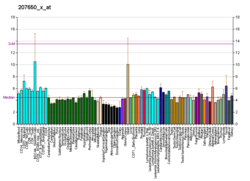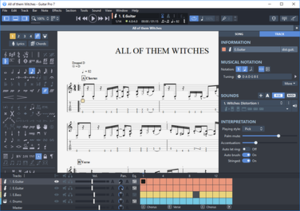프로스타글란딘 EP1 수용체
Prostaglandin EP1 receptor프로스타글란딘 E2 수용체 1(EP1)은 PTGER1 유전자에 의해 인코딩된 42kDa 프로스타글란딘 수용체다. EP는1 주로 프로스타그란딘 E2(PGE2)에 대한 세포 반응과 결합하고 중재하는 EP, EP12, EP3, EP4 및 EP 4개의 확인된 EP 수용체 중 하나이다. 또한 일반적으로 특정 다른 프로스타노이드에 대한 친화력과 반응성이 낮다(프로스타그란딘 수용체 참조).[5] 동물 모델 연구는 EP를1 다양한 생리적, 병리적 반응에 연관시켰다. 그러나 이러한 시험 동물과 사람 사이의 EP1 분포의 주요 차이뿐만 아니라 다른 복잡한 문제들 때문에 인간의 건강과 질병에서 이 수용기의 기능을 확립하는 것이 어렵다.[6]
유전자
PTGER1 유전자는 p13.12(즉, 19p13.12) 위치의 인간 19 염색체에 위치하며, 2 intron과 3 exon을 포함하고 있으며, 로도신 유사 수용체 제품군인 서브 패밀리 A14의 G단백질 결합 수용체(GPCR)에 대한 코드(Rhodopsin 유사 수용체#Subfamily A14 참조)[7]이다.
표현
쥐, 쥐, 기니피그에 대한 연구는 신장, 폐, 위, 팔라무스, 그리고 등근근위신경계 신경세포뿐만 아니라 몇몇 중추신경계 부위에서 EP1 Messenger RNA와 단백질이 신장의 유두관 수집관에서 발현되는 것을 발견했다.[8] 그러나 EP의1 발현 인간에게는 EP 수용체가1 인간 돛대 세포, 폐정맥, 각질세포, 근막, 대장 평활근 등에서 검출되어 그 표현이 더욱 제한적인 것으로 보인다.[6][9]
리간즈
리간즈 활성화
다음의 표준 프로스타글란딘은 EP와의1 결합과 활성화에 있어 다음과 같은 상대적 효력이 있다:PGE2≥PGE1>PGF2알파>PGD2. 수용체 결합 친화력 분리 상수 Kd(즉, 이용 가능한 EP1 수용체의 50%로 결합하는 데 필요한 리간드 농도)는 쥐 수용체의 경우 PGE1 ~40, 인간 수용체의 경우 PGE2의 경우 약 25nM이다.[9][10]
PGE는2 다중 프로스타노이드 수용체를 활성화하고 오메가 산화 및 베타 산화에 의한 세포 내 신진대사가 빨라 체내 반감기가 짧기 때문에 신진대사 저항성 EP 선택1 활성제는 EP의1 기능 연구에 유용하며 임상적으로 특정 질병 치료에 유용할 수 있다. EP를1 자극하는 데 있어 선택성이 높은 그러한 작용제 중 오직 한 가지만이 합성되어 확인되었는데, ONO-D1-OO4이다. 이 화합물은 PGE의2 경우 25nM과 비교하여 K 억제i 결합 값(생화학#Receptor/ligand 결합 친화도 참조)이 150nM이며 따라서 PGE보다2 약 5배 약하다.[9]
억제 리간즈
SC51322(Ki=13.8nM), GW-848687(Ki=8.6nM), ONO-8711, SC-19220, SC-51089 및 다음에 인용한 참고자료에 제시된 몇 가지 합성 화합물은 인간 질병의 동물 모델 연구에 사용된 EP의1 선택적 경쟁적 대항제들이다. 카바시린, 17페닐트리노르 PGE1 및 기타 여러 시험 화합물은 이중 EP1/EP3 길항제(대부분 시판된 프로스타노이드 수용체 길항제들은 수용체 선택성이 떨어진다)이다.[9]
세포 활성화 메커니즘
처음에 PGE나2 다른 자극적인 리간드에 바인딩되었을 때 EP는1 Gq 알파 서브 유닛(Gαq/11)-G 베타 감마 복합체를 포함하는 G 단백질을 이동시킨다. 이 두 하위 단위는 차례로 세포 세포 세포독성 Ca2+ 수준을 상승시키는 Phosphoinositide 3-kinase 경로를 자극하여 특정 단백질 키나제 C 이소폼의 활성화를 촉진하는 경로를 포함하는 Ca 민감 세포2+ 신호 경로를 조절한다.[6] 세포질 Ca의2+ 이러한 상승은 근육 세포도 수축시킬 수 있기 때문에 EP는1 수축형 프로스타노이드 수용체로 분류되어 왔다. 단백질 키나제 C의 활성화는 인산염에 다시 공급되어 활성화된 EP1 수용체를 감쇠시킨다(동맥성 감쇠화와 다른 유형의 프로스타노이드 수용체 및 비프로스타노이드 수용체도 감쇠할 수 있다(이성 감쇠화 참조). 이러한 약화 작용은 세포 내에서 더 이상의1 EP 수용체 활성화를 제한한다.[6][10][11] 이러한 경로의 동원과 동시에 리간드 활성 EP는1 ERK, p38 미토겐 활성 단백질 키나제, CREB 경로를 자극하여 세포 기능 반응을 유도한다.[12]
함수
EP가1 부족하도록 유전적으로 조작된 동물을 이용한 연구와 EP1 수용체 길항제 및 작용제와의 치료를 이용한 연구에 의해 보충된 연구는 이 수용체가 여러 기능을 하는 것으로 나타났다. 1) 중추신경계에 위치한 EP11 수용체로 인해 고갈증을 매개하지만, 쥐의 등뿌리 갱년기 뉴런에 위치한 E로1 인한 통증지각을 억제한다. 따라서 PGE는2 중추신경계에 투여할 때는 통증지각을 증가시키지만 시스템적으로[citation needed] 투여할 때는 통증지각을 억제한다.2) 아조시메탄 유도 및 APC 유전자 녹아웃 생쥐에서 대장암 발달을 촉진한다. 3) 당뇨병성 쥐와 자연적으로 비대해진 쥐에게 고혈압을 촉진시킨다. 4) 도파민 수용체 D1과 도파민 수용체 D2 신호의 활성화를 억제하여 쥐의 스트레스 유발 충동적 행동과 사회기능 장애를 억제한다. 5) Th1 세포 표현형에 대한 미확정 T세포 림프구의 분화를 강화하여 설치류의 면역 자극에 대한 알레르기 반응보다는 염증성 발달을 선호할 수 있다. 인간 세포에 대한 연구는 EP가1 T 세포에 유사한 기능을 제공한다는 것을 보여준다. 6) 설치류에서 장 점막이나 장 점막의 세포에 있는 나트륨-글루코오스 운반 단백질의 발현을 감소시킬 수 있다.[6][12][13][14]7) 급성 뇌손상의 병리학에 미분적으로 관여할 수 있다. EP1 수용체의 약리학적 억제 또는 유전자 삭제는 허혈성 뇌졸중,[15] 간질 발작,[16] 외과적으로 유발된 뇌손상[17], 외상성 뇌손상과 같은 신경학적 장애의 설치류 모델에서 유익하거나 유해한 영향을 발생시킨다.[18]
임상 연구
EP1 수용체 길항제들은 주로 고엽제 치료를 위해 임상적으로 연구되어 왔다. 동물 모델에서 다양한 고엽제 신드롬을 치료하는 데 어느 정도 효능이 있는 벤조푸란 함유 의약품인 SC51332, GW-848687X를 포함한 수많은 EP 길항제들이 개발되었다. 인간에게 유용한 것은 아직 보고된 바 없다.[9]
참고 항목
- 프로스타글란딘 수용체
- 프로스타노이드 수용체
- 프로스타글란딘 E2 수용체 2(EP2)
- 프로스타글란딘 E2 수용체 3(EP3)
- 프로스타글란딘 E2 수용체 4(EP4)
- 에이코사노이드수용체
참조
- ^ Jump up to: a b c GRCh38: 앙상블 릴리스 89: ENSG00000160951 - 앙상블, 2017년 5월
- ^ Jump up to: a b c GRCm38: 앙상블 릴리스 89: ENSMUSG000019464 - 앙상블, 2017년 5월
- ^ "Human PubMed Reference:". National Center for Biotechnology Information, U.S. National Library of Medicine.
- ^ "Mouse PubMed Reference:". National Center for Biotechnology Information, U.S. National Library of Medicine.
- ^ "Entrez Gene: PTGER1 prostaglandin E receptor 1 (subtype EP1), 42kDa".
- ^ Jump up to: a b c d e Woodward DF, Jones RL, Narumiya S (September 2011). "International Union of Basic and Clinical Pharmacology. LXXXIII: classification of prostanoid receptors, updating 15 years of progress". Pharmacological Reviews. 63 (3): 471–538. doi:10.1124/pr.110.003517. PMID 21752876.
- ^ "PTGER1 prostaglandin E receptor 1 [Homo sapiens (human)] - Gene - NCBI". www.ncbi.nlm.nih.gov.
- ^ Ricciotti E, FitzGerald GA (May 2011). "Prostaglandins and inflammation". Arteriosclerosis, Thrombosis, and Vascular Biology. 31 (5): 986–1000. doi:10.1161/ATVBAHA.110.207449. PMC 3081099. PMID 21508345.
- ^ Jump up to: a b c d e Markovič T, Jakopin Ž, Dolenc MS, Mlinarič-Raščan I (January 2017). "Structural features of subtype-selective EP receptor modulators". Drug Discovery Today. 22 (1): 57–71. doi:10.1016/j.drudis.2016.08.003. PMID 27506873.
- ^ Jump up to: a b Narumiya S, Sugimoto Y, Ushikubi F (October 1999). "Prostanoid receptors: structures, properties, and functions". Physiological Reviews. 79 (4): 1193–226. doi:10.1152/physrev.1999.79.4.1193. PMID 10508233.
- ^ Korbecki J, Baranowska-Bosiacka I, Gutowska I, Chlubek D (2014). "Cyclooxygenase pathways". Acta Biochimica Polonica. 61 (4): 639–49. doi:10.18388/abp.2014_1825. PMID 25343148.
- ^ Jump up to: a b Moreno JJ (December 2016). "Eicosanoid receptors: Targets for the treatment of disrupted intestinal epithelial homeostasis". European Journal of Pharmacology. 796: 7–19. doi:10.1016/j.ejphar.2016.12.004. PMID 27940058. S2CID 1513449.
- ^ Matsuoka T, Narumiya S (August 2008). "The roles of prostanoids in infection and sickness behaviors". Journal of Infection and Chemotherapy. 14 (4): 270–8. doi:10.1007/s10156-008-0622-3. PMID 18709530. S2CID 207058745.
- ^ Matsuoka T, Narumiya S (September 2007). "Prostaglandin receptor signaling in disease". TheScientificWorldJournal. 7: 1329–47. doi:10.1100/tsw.2007.182. PMC 5901339. PMID 17767353.
- ^ Kawano T, Anrather J, Zhou P, Park L, Wang G, Frys KA, Kunz A, Cho S, Orio M, Iadecola C (February 2006). "Prostaglandin E2 EP1 receptors: downstream effectors of COX-2 neurotoxicity". Nature Medicine. 12 (2): 225–9. doi:10.1038/nm1362. PMID 16432513. S2CID 33649705.
- ^ Fischborn SV, Soerensen J, Potschka H (September 2010). "Targeting the prostaglandin E2 EP1 receptor and cyclooxygenase-2 in the amygdala kindling model in mice". Epilepsy Research. 91 (1): 57–65. doi:10.1016/j.eplepsyres.2010.06.012. PMID 20655707. S2CID 36191106.
- ^ Khatibi NH, Jadhav V, Matus B, Fathali N, Martin R, Applegate R, Tang J, Zhang JH (2011). "Prostaglandin E2 EP1 receptor inhibition fails to provide neuroprotection in surgically induced brain-injured mice". Acta Neurochirurgica. Supplement. Acta Neurochirurgica Supplementum. 111: 277–81. doi:10.1007/978-3-7091-0693-8_46. ISBN 978-3-7091-0692-1. PMC 3569069. PMID 21725768.
- ^ Glushakov AV, Fazal JA, Narumiya S, Doré S (2014). "Role of the prostaglandin E2 EP1 receptor in traumatic brain injury". PLOS ONE. 9 (11): e113689. Bibcode:2014PLoSO...9k3689G. doi:10.1371/journal.pone.0113689. PMC 4245217. PMID 25426930.
추가 읽기
- Coleman RA, Smith WL, Narumiya S (June 1994). "International Union of Pharmacology classification of prostanoid receptors: properties, distribution, and structure of the receptors and their subtypes". Pharmacological Reviews. 46 (2): 205–29. PMID 7938166.
- Lee TY, Watanabe Y (May 1975). "A nonlinear regression model as applied to the comparison of axis-angles of electrocardiographic systems". Japanese Heart Journal. 16 (3): 243–56. doi:10.1536/ihj.16.243. PMID 1160156.
- Duncan AM, Anderson LL, Funk CD, Abramovitz M, Adam M (February 1995). "Chromosomal localization of the human prostanoid receptor gene family". Genomics. 25 (3): 740–2. doi:10.1016/0888-7543(95)80022-E. PMID 7759114.
- Funk CD, Furci L, FitzGerald GA, Grygorczyk R, Rochette C, Bayne MA, Abramovitz M, Adam M, Metters KM (December 1993). "Cloning and expression of a cDNA for the human prostaglandin E receptor EP1 subtype". The Journal of Biological Chemistry. 268 (35): 26767–72. doi:10.1016/S0021-9258(19)74379-8. PMID 8253813.
- Kurihara Y, Endo H, Kondo H (January 2001). "Induction of IL-6 via the EP3 subtype of prostaglandin E receptor in rat adjuvant-arthritic synovial cells". Inflammation Research. 50 (1): 1–5. doi:10.1007/s000110050716. PMID 11235015. S2CID 21908528.
- Kyveris A, Maruscak E, Senchyna M (March 2002). "Optimization of RNA isolation from human ocular tissues and analysis of prostanoid receptor mRNA expression using RT-PCR". Molecular Vision. 8: 51–8. PMID 11951086.
- Matsuoka Y, Furuyashiki T, Bito H, Ushikubi F, Tanaka Y, Kobayashi T, Muro S, Satoh N, Kayahara T, Higashi M, Mizoguchi A, Shichi H, Fukuda Y, Nakao K, Narumiya S (April 2003). "Impaired adrenocorticotropic hormone response to bacterial endotoxin in mice deficient in prostaglandin E receptor EP1 and EP3 subtypes". Proceedings of the National Academy of Sciences of the United States of America. 100 (7): 4132–7. Bibcode:2003PNAS..100.4132M. doi:10.1073/pnas.0633341100. PMC 153060. PMID 12642666.
- Richards JA, Brueggemeier RW (June 2003). "Prostaglandin E2 regulates aromatase activity and expression in human adipose stromal cells via two distinct receptor subtypes". The Journal of Clinical Endocrinology and Metabolism. 88 (6): 2810–6. doi:10.1210/jc.2002-021475. PMID 12788892.
- Kitamura T, Itoh M, Noda T, Tani K, Kobayashi M, Maruyama T, Kobayashi K, Ohuchida S, Sugimura T, Wakabayashi K (July 2003). "Combined effects of prostaglandin E receptor subtype EP1 and subtype EP4 antagonists on intestinal tumorigenesis in adenomatous polyposis coli gene knockout mice". Cancer Science. 94 (7): 618–21. doi:10.1111/j.1349-7006.2003.tb01492.x. PMID 12841871. S2CID 9202306.
- Moreland RB, Kim N, Nehra A, Goldstein I, Traish A (October 2003). "Functional prostaglandin E (EP) receptors in human penile corpus cavernosum". International Journal of Impotence Research. 15 (5): 362–8. doi:10.1038/sj.ijir.3901042. PMID 14562138.
- Su JL, Shih JY, Yen ML, Jeng YM, Chang CC, Hsieh CY, Wei LH, Yang PC, Kuo ML (January 2004). "Cyclooxygenase-2 induces EP1- and HER-2/Neu-dependent vascular endothelial growth factor-C up-regulation: a novel mechanism of lymphangiogenesis in lung adenocarcinoma". Cancer Research. 64 (2): 554–64. doi:10.1158/0008-5472.CAN-03-1301. PMID 14744769.
- Wu T, Wu H, Wang J, Wang J (March 2011). "Expression and cellular localization of cyclooxygenases and prostaglandin E synthases in the hemorrhagic brain". Journal of Neuroinflammation. 8: 22. doi:10.1186/1742-2094-8-22. PMC 3062590. PMID 21385433.
- Han C, Wu T (June 2005). "Cyclooxygenase-2-derived prostaglandin E2 promotes human cholangiocarcinoma cell growth and invasion through EP1 receptor-mediated activation of the epidermal growth factor receptor and Akt". The Journal of Biological Chemistry. 280 (25): 24053–63. doi:10.1074/jbc.M500562200. PMID 15855163.
- Nicola C, Timoshenko AV, Dixon SJ, Lala PK, Chakraborty C (August 2005). "EP1 receptor-mediated migration of the first trimester human extravillous trophoblast: the role of intracellular calcium and calpain". The Journal of Clinical Endocrinology and Metabolism. 90 (8): 4736–46. doi:10.1210/jc.2005-0413. PMID 15886234.
- Han C, Michalopoulos GK, Wu T (April 2006). "Prostaglandin E2 receptor EP1 transactivates EGFR/MET receptor tyrosine kinases and enhances invasiveness in human hepatocellular carcinoma cells". Journal of Cellular Physiology. 207 (1): 261–70. doi:10.1002/jcp.20560. PMID 16331686. S2CID 8550461.
- Durrenberger PF, Facer P, Casula MA, Yiangou Y, Gray RA, Chessell IP, Day NC, Collins SD, Bingham S, Wilson AW, Elliot D, Birch R, Anand P (January 2006). "Prostanoid receptor EP1 and Cox-2 in injured human nerves and a rat model of nerve injury: a time-course study". BMC Neurology. 6: 1. doi:10.1186/1471-2377-6-1. PMC 1361784. PMID 16393343.
- Zhao X, Wu T, Chang CF, Wu H, Han X, Li Q, Gao Y, Li Q, Hou Z, Maruyama T, Zhang J, Wang J (May 2015). "Toxic role of prostaglandin E2 receptor EP1 after intracerebral hemorrhage in mice". Brain, Behavior, and Immunity. 46: 293–310. doi:10.1016/j.bbi.2015.02.011. PMC 4422065. PMID 25697396.
- McGraw DW, Mihlbachler KA, Schwarb MR, Rahman FF, Small KM, Almoosa KF, Liggett SB (May 2006). "Airway smooth muscle prostaglandin-EP1 receptors directly modulate beta2-adrenergic receptors within a unique heterodimeric complex". The Journal of Clinical Investigation. 116 (5): 1400–9. doi:10.1172/JCI25840. PMC 1451203. PMID 16670773.
- Horita H, Kuroda E, Hachisuga T, Kashimura M, Yamashita U (July 2007). "Induction of prostaglandin E2 production by leukemia inhibitory factor promotes migration of first trimester extravillous trophoblast cell line, HTR-8/SVneo". Human Reproduction. 22 (7): 1801–9. doi:10.1093/humrep/dem125. PMID 17525067.
외부 링크
- "Prostanoid Receptors: EP1". IUPHAR Database of Receptors and Ion Channels. International Union of Basic and Clinical Pharmacology.
이 기사는 공공영역에 있는 미국 국립 의학 도서관의 텍스트를 통합하고 있다.








